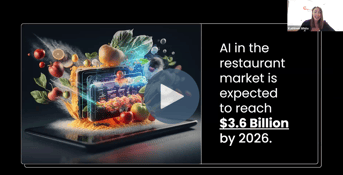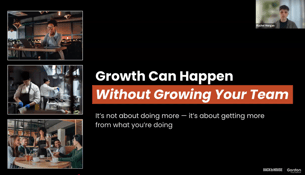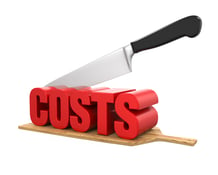Profitable restaurants have several features in common—healthy cash flow, strong team members, and data-driven decision making, to name a few. These features are the basic keys to survival in a fiercely competitive industry. But how do the biggest brands rise to the top? How do industry leaders increase restaurant profitability without compromising quality and customer satisfaction?
The most successful restaurants are those that have learned to harness leading edge technologies. Restaurants face unique challenges including razor-thin profit margins, fluctuating costs, and high labor turnover. The right technology mix can help you manage these challenges with greater accuracy, speed, and precision.
Below are five ways restaurants are leveraging emergent technologies to save money, increase restaurant sales, and meet their biggest challenges head-on.
#1: Reduce Human Error
At its most basic, restaurant technology should reduce the likelihood of human error. For instance, familiar tools like the point-of-sale system (POS) and Kitchen Display System (KDS) make it possible to manage orders, track tickets, and ensure that nothing falls through the cracks.
People make mistakes. Life in the kitchen moves fast, and this speed can increase the possibility of human error. We juggle handwritten orders, scribble notes, and even misplace tickets. Dishes have to be remade, orders get backed up, and delivery times are compromised.
And when that happens, restaurants lose money.
POS and KDS technologies digitize these functions, reducing the possibility of human error and helping restaurants save money at every turn. The same is true of innovative solutions like QR Code Ordering, which significantly reduces the likelihood of ordering errors, and robotic automation, which improves meal consistency. Collectively, these solutions offer an array of new ways to increase restaurant profitability by improving your back-of-house efficiency.
#2: Cut Down on Food Waste
Food waste is a costly and common problem for restaurants. Most restaurants will spend anywhere between 28% and 35% of their revenue on food costs. And those costs can spike based on changes in supply and demand. Meanwhile, research shows that restaurants waste up to 10% of food purchased before it ever reaches the consumer.
Put these figures together, and it means a significant chunk of change may be leaving your restaurant by way of the dumpster. Many restaurants turn to technological solutions in order to disrupt this costly pattern.
For example, inventory tracking solutions give you complete visibility into inventory levels. This, in turn, provides you with the data needed to adjust order sizes, modify order frequency, and ultimately prevent food spoilage.
Many restaurants also deploy recipe development solutions, which can help determine optimal portion sizing in order to reduce leftover waste from guests. Some industry leaders even use food waste management solutions, which can be effective at increasing restaurant profitability by repurposing excess food, or at least, turning that food into tax-deductible donations.
Reducing waste is one of the clearest paths to increasing restaurant profitability, and the right technology can help you do it with greater accuracy and efficiency.
#3: Maximize Menu Item Profitability
One of the best ways to increase restaurant sales is to ensure that your menu is producing results. Menu analysis is complex and time-consuming. But your profit margins depend on finding the right balance between food costs and sales. You need to know which menu items are winners and which are losers.
Fortunately, you can choose from a variety of recipe software platforms that are designed to take the guesswork out of menu analysis. The best platforms will measure your real-time food costs against your POS sales data so that you can see the exact profit margin on each dish, even as food costs fluctuate.
You can also use this data to modify recipes on the platform. This function lets you tweak ingredients and portion sizes in order to observe the impact on projected profits. Recipe software platforms also track profit trends over time. So when you do decide to implement a recipe change, you can easily measure the impact of this change on sales and profit margins.
The right recipe software platform can reduce your food costs, improve the performance of your menu offerings, and increase restaurant profitability.
#4: Track Spending with Accuracy and Ease
There’s a lot that goes into balancing a restaurant ledger. You have supplier prices to compare, inventory to track, menu prices to optimize, and sales to analyze. Therefore, you must have a complete and accurate picture of your restaurant’s cash flow at all times. This requires a robust mix of software and data solutions.
When you combine a strong POS system with a reliable inventory and/or purchasing solution, you can see exactly what you're spending, making, and throwing out. You can keep a close watch on your margins and make spending decisions with data-driven precision.
Some of the best management solutions enable data entry via mobile devices, integrate seamlessly with vendor systems, and clear the mountain of paperwork off of your desk. Together, these solutions can be effective at improving sales, minimizing expenses, and increasing restaurant profitability.
#5: Hire Faster and More Efficiently
Businesses are competing for talent like never before. Restaurants, in particular, face significant staffing shortages and high employee turnover. Many restaurants are under constant pressure to recruit and hire with speed and efficiency. Hiring technology platforms are proving an invaluable tool for offsetting that pressure, and the costs that come with it.
The Center for Hospitality Research at Cornell estimates that the average cost of replacing an employee is around $5,864 per person. That cost includes expenses like job posting and advertising, as well as time spent on interviewing, recruiting, and training. The longer it takes to hire, the more the process costs. Again, efficiency is key.
Hiring platforms automate as many parts of the process as possible, allowing you to amplify your message, reach a wider pool of candidates, and zero in on the candidates most suited for the job. The best platforms will offer single-click, multi-channel job listings, automated vetting tools, interview scheduling features, streamlined onboarding features, and more.
Are you ready to increase your restaurant profitability?
Industry leaders are already using these rapidly evolving technologies to their advantage–discovering new ways to save, new ways to increase restaurant sales, and new ways to grow in a highly competitive space. If you’re not sure how to strike the right mix of tech-based solutions that can increase restaurant profitability for your business, schedule a free discovery session with one of our experts to discuss all of your options.
Written with help from Grace Dickinson.





